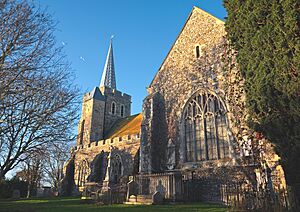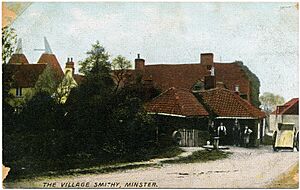Minster-in-Thanet facts for kids
Quick facts for kids Minster |
|
|---|---|
 Church of St Mary the Virgin, Minster-in-Thanet |
|
| Population | 3,569 (2011) |
| OS grid reference | TR308645 |
| Civil parish |
|
| District |
|
| Shire county | |
| Region | |
| Country | England |
| Sovereign state | United Kingdom |
| Post town | RAMSGATE |
| Postcode district | CT12 |
| Dialling code | 01843 |
| Police | Kent |
| Fire | Kent |
| Ambulance | South East Coast |
| EU Parliament | South East England |
| UK Parliament |
|
Minster, also known as Minster-in-Thanet, is a village and civil parish in the Thanet area of Kent, England. It is home to Minster in Thanet Priory. The village is west of Ramsgate and northeast of Canterbury. It lies near Kent International Airport and the River Stour. Minster is also known as the "ancient capital of Thanet". In 2011, the small area of Ebbsfleet was included with Minster.
Contents
What's in a Name? The Meaning of Minster
The name "Minster" comes from an old Latin word, monasterium. This word means a place where monks or nuns live, like an abbey or monastery. Many places in England and Europe have similar names because they once had such religious buildings.
Minster's Long History
People have lived in Minster-in-Thanet for a very long time. Archaeology shows there was a settlement here during the Bronze Age. Later, the area became part of the Roman Empire. Around 450 AD, a group of people called the Jutes came to Minster and started their own settlement.
Anglo-Saxon Times: Monks, Nuns, and Vikings
In 597 AD, a very important person named Augustine of Canterbury is said to have landed with 40 men at nearby Ebbsfleet. This spot is within the Minster-in-Thanet area. Augustine later went on to start a monastery in Canterbury. A cross now marks the place where he landed.
Minster itself began as a monastic settlement in 670 AD. The buildings are still used by nuns today. The first abbey in the village was started by St Domneva, a noblewoman who had lost her husband. Her daughter, St Mildred, became the first leader (abbess) of the abbey.
There's a story that Domneva was given as much land as a deer (hind) could run over in a day. This deer is still the village symbol. The land marked by the deer was called Cursus Cerve or St Mildred’s Lynch. Sadly, Viking raiders later destroyed the abbey.
Another important abbess after St Mildred was St Edburga. She was the daughter of King Centwine of the West Saxons.
The third known abbess was Sigeburh, who was active around 762 AD. She is known from old writings and royal documents. In 761 AD, Offa, the king of the Mercians, gave Sigeburh a special permission to avoid paying tolls. This was a privilege that an earlier king had given to Abbess Mildred. Around 763 AD, Eadberht II, the king of Kent, also allowed her to avoid tolls on ships at Sarre and Fordwich.
Vikings attacked the area around Minster in 850 AD.
Norman Times: St Mary's Church
The local church, St Mary-the-Virgin, was mostly built during the Norman period. However, it also has older parts that are still a bit of a mystery. The main part of the church, called the nave, is very impressive with five sections. The central area, called the crossing, has an old chalk block vaulting (curved ceiling).
The chancel (the part of the church near the altar) was built in an early English style. It has flying buttresses (supports on the outside) to stop the walls from spreading apart. Inside, there are some beautiful wooden seats called misericords, which are about 600 years old.
The church tower has a strange small tower at its corner. Locals call it a Saxon watch tower, but it's partly made from Caen stone, which came from France. It might have been built around the time of the Norman Conquest in an older style. A doorway in this small tower opens out high above the current roof!
The church was used by both the monks of a second abbey (which was connected to St Augustine's Abbey in Canterbury) and by the local villagers as their parish church. This abbey was closed down in 1534 during a time called the dissolution.
Nineteenth Century Changes
Maps from 1876 show a Methodist chapel on St Mildred's Road. By 1898, it had become a Roman Catholic chapel called "St Mildred's R.C. chapel." It was also known as "St Mildred's church and presbytery" (a house for priests). The chapel later closed. In 2010, permission to knock it down was refused, so it was turned into a private home.
Twentieth Century: Minster Abbey Today
Minster Abbey is a house that includes parts of the old Anglo-Saxon abbey. Some say it's the oldest house in England that has been lived in continuously. Today, it's home to the village's third religious community: Roman Catholic Benedictine sisters. They came here in 1937 as refugees escaping Nazi Germany. The community is still active and has sisters from many different countries.
The Priory also looks after a special item: a relic (a sacred object) of St Mildred. This relic had been kept in a church in Deventer in the Netherlands since the Reformation.
Minster's Natural Landscape
Minster generally has a flat landscape. The main natural features are marshes (wetlands), farms, and rivers. The local council has said that Minster Marshes, south of the village, are not very stable. Some parts of Minster, especially in the south, have experienced flooding.
Land reclamation has a long history in Minster and Monkton. This means that land that was once underwater or marshy has been turned into usable land. The monks themselves did some of the first reclamation work here.
Learning in Minster: Local Schools
The main Primary School in the village is called "Minster Church of England Primary School." It serves the children of the village. As of 2022, there were 383 students attending the school.
Getting Around: Transport in Minster
Minster railway station is south of the village. It's on the train line that goes from Canterbury West to Ramsgate. It's also a junction for the Kent Coast Line.
Bus services in the area are provided by Stagecoach.
Remembering Heroes: Military History
Minster has a war memorial to remember those who died in World War I and World War II. This memorial is located in St Mary's church.
In 2013, Minster held a special event to remember Jean de Selys Longchamps. He was a Belgian fighter pilot who is buried in Minster cemetery. The event was organized by the Minster & Monkton Royal British Legion and the Minster Parish Council. Important people, like the Lord Lieutenant of Kent and the Chief of the Belgian Air Defense, attended.
Famous People Connected to Minster
- St Augustine of Canterbury is said to have landed with 40 men at Ebbsfleet, which is part of Minster parish. He then started his important work in Canterbury. A cross near Cliffsend marks this event.
- Richard Culmer, a Puritan minister, was known as Blue Dick Culmer. The people of Minster did not want him as their minister, and his name is still left off the list of ministers in the church porch.
See also
 In Spanish: Minster (Thanet) para niños
In Spanish: Minster (Thanet) para niños



